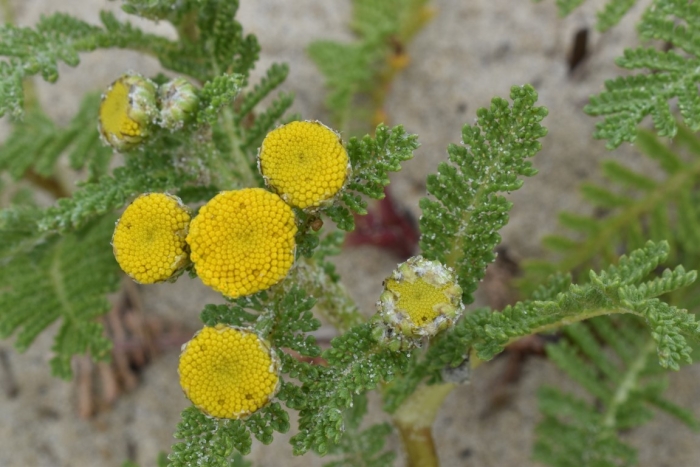Lake Huron Tansy
(Tanacetum bipinnatum)
Lake Huron Tansy (Tanacetum bipinnatum)
/
/

Gail A Baker
CC BY 4.0
Image By:
Gail A Baker
Recorded By:
Copyright:
CC BY 4.0
Copyright Notice:
Photo by: Gail A Baker | License Type: CC BY 4.0 | License URL: http://creativecommons.org/licenses/by/4.0/ | Rights Holder: Gail A Baker | Publisher: iNaturalist | Date Created: 2021-06-28T10:27:59-07:00 |















































Estimated Native Range
Summary
Tanacetum bipinnatum, commonly known as Lake Huron Tansy, is an evergreen perennial herb native to a variety of habitats including coastal dunes, bluffs, and meadows in Eastern Europe to the Russian Far East, Subarctic America to the North and West USA.. It typically grows to a height of 1-2 feet (0.3-0.6 meters) and a width of 0.5-1 feet (0.2-0.3 meters). This plant features finely divided, fern-like leaves and bears clusters of bright yellow, button-like flowers in the summer and fall, which are modest in size but can be quite numerous, adding a splash of color to the garden.
Lake Huron Tansy is valued for its drought tolerance and ability to thrive in poor, sandy soils, making it suitable for xeriscaping and naturalistic plantings. It is often used in rock gardens, as a border plant, or for erosion control on slopes. This tansy requires full sun and well-drained soil to flourish and is relatively low-maintenance once established. While it is not known for significant pest or disease issues, it can be susceptible to root rot in poorly drained soils. Gardeners should be cautious as Tanacetum species can be toxic to livestock and pets if ingested in large quantities.CC BY-SA 4.0
Lake Huron Tansy is valued for its drought tolerance and ability to thrive in poor, sandy soils, making it suitable for xeriscaping and naturalistic plantings. It is often used in rock gardens, as a border plant, or for erosion control on slopes. This tansy requires full sun and well-drained soil to flourish and is relatively low-maintenance once established. While it is not known for significant pest or disease issues, it can be susceptible to root rot in poorly drained soils. Gardeners should be cautious as Tanacetum species can be toxic to livestock and pets if ingested in large quantities.CC BY-SA 4.0
Plant Description
- Plant Type: Herb
- Height: 1-2 feet
- Width: 0.5-1 feet
- Growth Rate: Moderate
- Flower Color: Yellow
- Flowering Season: Fall, Summer
- Leaf Retention: Evergreen
Growth Requirements
- Sun: Full Sun
- Water: Very Low
- Drainage: Fast
Common Uses
Bee Garden, Butterfly Garden, Deer Resistant, Drought Tolerant, Erosion Control, Fragrant, Low Maintenance, Rabbit Resistant, Rock Garden, Salt Tolerant
Natural Habitat
native to a variety of habitats including coastal dunes, bluffs, and meadows in Eastern Europe to the Russian Far East, Subarctic America to the North and West USA.
Other Names
Common Names: Camphor Tansy, Dwarf Tansy, Tanaisie Bipennée, Dvärgrenfana
Scientific Names: , Tanacetum bipinnatum, Chrysanthemum bipinnatum subsp. bipinnatum, Tanacetum huronense var. huronense, Tanacetum horonense, Tanacetum huronense f. huronense, Tanacetum kotzebuensis,
GBIF Accepted Name: Tanacetum bipinnatum (L.) Sch.Bip.